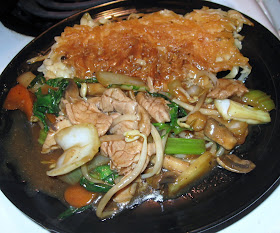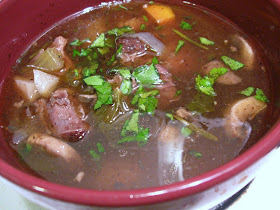Ingredients:
1 1/2 Tablespoons olive oil
0 - 1/2 pound stew meat [If you're going to use meat, lamb or goat would probably be most appropriate. Pork is right out. I don't have a local source of stew lamb or goat (although I'm sure it's not hard to come by in Miami if you don't insist on the source being between UM and my home. I used beef.]
3 large cloves garlic, thinly sliced

1 bunch celery, chopped into 2-inch lengths
1 bay leaf
1/2 teaspoon turmeric
1/2 teaspoon cumin
1/4 teaspoon paprika
1/4 teaspoon black pepper
1/2 cup cold water
7 ounces (by weight) pitted Moroccan green olives, drained, rinsed and halved if large [I chose my grocery poorly and didn't find specifically Moroccan olives so I think I'm missing some spices that would have been included. I picked a tart olive without herbs in the brine to substitute.]
7 ounces (by weight) artichoke hearts, roughly chopped [My grocery had two choices and I picked the less vinegary one. The dish benefits from a bit of acid so you should pick the other one.]
1. Heat the olive oil over medium-high heat until shimmering. add the meat and cook until half browned. Salt judiciously with a mind towards how salty your olives are. Add the garlic, turn the heat down to medium, and cook until the garlic is fragrant and becoming translucent.
2. Add
 the bay leaf and spices. Cook briefly until spices are fragrant. Add celery and water. Salt again otherwise your celery will be extra bland, but be careful. Stir well, bring to a boil, cover, turn heat down to low and cook, stirring occasionally, 25 minutes until celery is just getting tender.
the bay leaf and spices. Cook briefly until spices are fragrant. Add celery and water. Salt again otherwise your celery will be extra bland, but be careful. Stir well, bring to a boil, cover, turn heat down to low and cook, stirring occasionally, 25 minutes until celery is just getting tender.3. Add olives and artichoke hearts. Turn heat up a little and simmer uncovered for 20 minutes more until most of the water has evaporated.
Adjust seasoning and acid level. Garnish with parsley and/or cilantro, let cool a bit as hot olives are just weird, and serve over couscous.

The celery and artichoke end up quite soft so the slight chew of the olives and the meaty bite of the beef are important to add textural interest to the dish. Even after the cooking, the olives are pretty intense, dominating the dish, but the mild celery mellows them out and adds a slight sweetness. It's no great showcase for the celery, but the celery isn't just filler either. The artichoke hearts don't do much. There's some hint of their flavor in the mix, particularly as some of the leaves have come off and fallen apart, but it's mild and not far from the cooked celery. The spices counterpoint, laying earthiness under the tartness of the olives and tying the various elements together. The beef adds some bulk, but I don't think the flavor quite works. Go with the lamb or mutton if you can get it. A little gaminess would stand up better to the other flavors here. Other than that, I do like the dish. It's an unusual (to me) flavor combination, but not hard to get used to and quite pleasant.













































